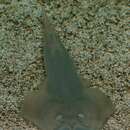en
names in breadcrumbs


The common shovelnose ray, giant shovelnose ray or giant guitarfish[1] (Glaucostegus typus) is a species of fish in the Rhinobatidae family found in the central Indo-Pacific, ranging from India to the East China Sea, Solomon Islands and northern Australia.[1][3][4] It is found in shallow coastal areas to a depth of at least 100 m (330 ft), including mangrove, estuaries and reportedly also in freshwaters.[1][3][4] It reaches up to 2.7 m (8.9 ft) in length, and is greyish-brown to yellowish-brown above with a paler snout.[4]
This species has been tested for colour vision using choice experiments that control for brightness. It was the first rigorous behavioural evidence for colour vision in any elasmobranch.[5]
{{cite journal}}: CS1 maint: multiple names: authors list (link) The common shovelnose ray, giant shovelnose ray or giant guitarfish (Glaucostegus typus) is a species of fish in the Rhinobatidae family found in the central Indo-Pacific, ranging from India to the East China Sea, Solomon Islands and northern Australia. It is found in shallow coastal areas to a depth of at least 100 m (330 ft), including mangrove, estuaries and reportedly also in freshwaters. It reaches up to 2.7 m (8.9 ft) in length, and is greyish-brown to yellowish-brown above with a paler snout.
This species has been tested for colour vision using choice experiments that control for brightness. It was the first rigorous behavioural evidence for colour vision in any elasmobranch.